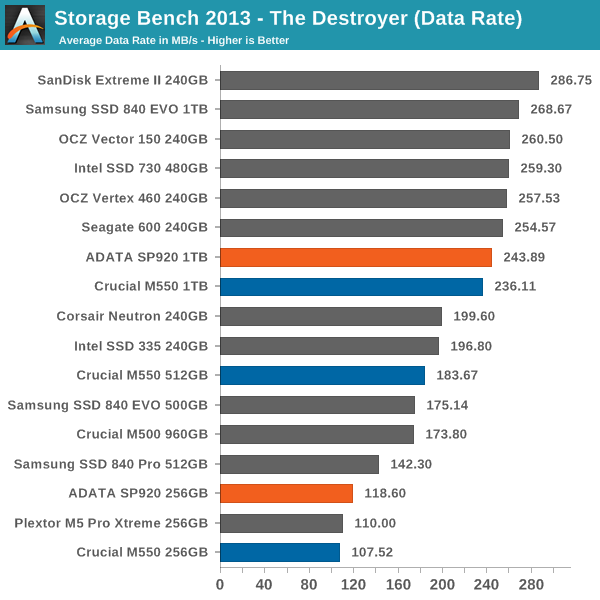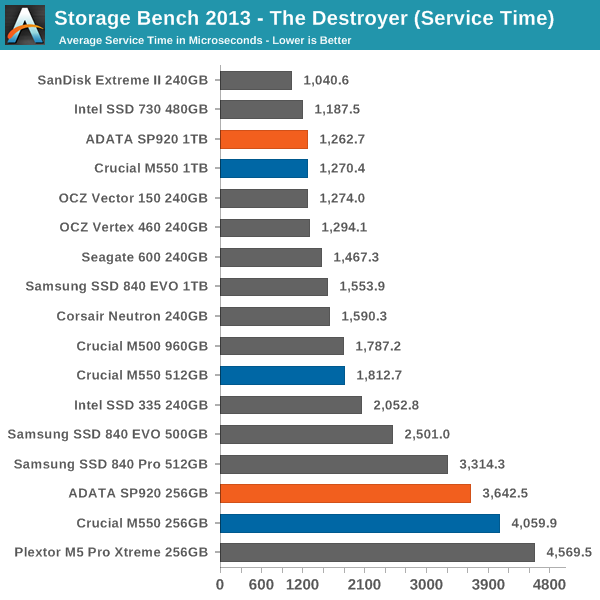ADATA SP920 (128GB, 256GB, 512GB & 1TB) Review
by Kristian Vättö on April 1, 2014 8:30 PM ESTAnandTech Storage Bench 2013
Our Storage Bench 2013 focuses on worst-case multitasking and IO consistency. Similar to our earlier Storage Benches, the test is still application trace based—we record all IO requests made to a test system and play them back on the drive we're testing and run statistical analysis on the drive's responses. There are 49.8 million IO operations in total with 1583.0GB of reads and 875.6GB of writes. I'm not including the full description of the test for better readability, so make sure to read our Storage Bench 2013 introduction for the full details.
| AnandTech Storage Bench 2013 - The Destroyer | ||
| Workload | Description | Applications Used |
| Photo Sync/Editing | Import images, edit, export | Adobe Photoshop CS6, Adobe Lightroom 4, Dropbox |
| Gaming | Download/install games, play games | Steam, Deus Ex, Skyrim, Starcraft 2, BioShock Infinite |
| Virtualization | Run/manage VM, use general apps inside VM | VirtualBox |
| General Productivity | Browse the web, manage local email, copy files, encrypt/decrypt files, backup system, download content, virus/malware scan | Chrome, IE10, Outlook, Windows 8, AxCrypt, uTorrent, AdAware |
| Video Playback | Copy and watch movies | Windows 8 |
| Application Development | Compile projects, check out code, download code samples | Visual Studio 2012 |
We are reporting two primary metrics with the Destroyer: average data rate in MB/s and average service time in microseconds. The former gives you an idea of the throughput of the drive during the time that it was running the test workload. This can be a very good indication of overall performance. What average data rate doesn't do a good job of is taking into account response time of very bursty (read: high queue depth) IO. By reporting average service time we heavily weigh latency for queued IOs. You'll note that this is a metric we've been reporting in our enterprise benchmarks for a while now. With the client tests maturing, the time was right for a little convergence.

Surprisingly the 256GB SP920 is faster than 256GB M550 even though the SP920 has fewer NAND dies. The main reason Crucial went with 64Gbit die for 128GB and 256GB models was increased performance, but it looks like that mainly applies the 128GB version. Of course, ~10MB/s isn't a big difference but it's still interesting that the performance hit from 128Gbit NAND is mostly a non-issue for the 256GB model.











30 Comments
View All Comments
Guspaz - Thursday, April 3, 2014 - link
I agree. I read the whole article more often than not, but on some articles, where I'm pressed for time or don't have the same degree of interest in the subject of the review, I just read the introduction and the final words. As such, getting the gist of the whole article is very important.Heck, even when I do read the whole article, it's still important. Sometimes a good summary at the end points out things that I missed, or gives me a better idea how to interpret the results.
Kristian Vättö - Thursday, April 3, 2014 - link
I've been with AnandTech for three years now, so I'm not exactly new :)Since the SP920 is a rebranded M550, I think it's a must to look at the M550 review as well, which is why I referred to it so much. Now that I look it at, a mention of the SP920's position in the market wouldn't have hurt but as I mentioned in the introduction, our M550 review has broad coverage of that along with plenty of other stuff.
hrrmph - Wednesday, April 2, 2014 - link
Adata claims to have a software toolbox to ease the inconvenience of occasionally needing to do a Secure Erase and other functions. Crucial / Micron doesn't seem to offer that.Samsung offers RAM caching software. Neither Adata nor Crucial / Micron seems to offer that.
hrrmph - Wednesday, April 2, 2014 - link
I would really appreciate it if the hole in the chart could be filled (the Samsung EVO's ratings with 25% spare area).I take it that getting the sample drives from Samsung has been difficult?
Kristian Vättö - Thursday, April 3, 2014 - link
We do have EVO samples (well, Anand has, I don't) but you can see the EVO's OP behavior in the EVO mSATA reviewhttp://www.anandtech.com/show/7594/samsung-ssd-840...
nofly - Friday, April 4, 2014 - link
Will those PCIe drives mentioned in the article be an upgrade option for older motherboards (like a PCIe card) or will new hardware be required ?Kristian Vättö - Friday, April 4, 2014 - link
Most PCIe SSDs in the near future will likely be just regular PCIe cards. Later we may see transition to 2.5" when/if SATA Express becomes a standard.Alientech - Saturday, April 5, 2014 - link
The new ST3000DM001-1E6166 drives with the FC4x firmware seems to be using Shingled Magnetic Recording. Which means we need SSD caching all the more. Sure wish every one would pack one with the drive. With HDD write speeds dropping through the floor now, its a must. Even 250MB write speeds of a SSD is a huge improvement.sammarth - Monday, April 28, 2014 - link
<a href="http://seoexpertzs.wordpress.com">Sammarth... nice thanks for share usgamoniac - Wednesday, May 20, 2015 - link
Hi Kristian, on power consumption, you mentioned you were posting an update with HIPM+DIPM enabled. I searched through AT but didn't find any update. I know this is a year-old article but it would be nice to see that, since there were some SP920 on sales now. It seems like a pretty solid drive with very competitive pricing (256GB for $89 on newegg). Thanks.